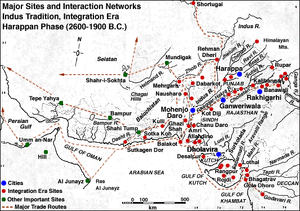Surkotada
| Author:Laxman Burdak, IFS (R) |

Surkotada is an archaeological site located in Kutch, Gujarat, India. It is a site belonging to Indus Valley Civilisation (IVC).[1][2]
Location
The site at Surkotada is located 160 km north-east of Bhuj, in the district of Kutch, Gujarat.
Site of Indus Valley Civilisation
It is a smaller fortified IVC site with 1.4 hectares (3.5 acres) in area.[3]
The ancient mound stands surrounded by an undulating rising ground clustered by small sandstone hills. These hills are covered with red laterite soil giving the entire region a reddish brown colour. The vegetation is scarce and consists of cactus, small babul and pilu trees and thorny shrubs. These give green patches to the red environment. The mound was discovered in 1964 by Shri J. P. Joshi of the Archaeological Survey of India. The mound is higher on the western side and lower on the eastern side and has an average height of 5 to 8 m . In the ancient days, a river 750 m wide flowed past the north-eastern side of the site. This river, which emptied into the Little Rann, might have been an important reason for siting the town here. Now this river is only a small nalla (stream).
Horse remains: Surkotada site contains horse remains dated to ca. 2000 BCE, which is considered a significant observation with respect to Indus Valley Civilisation. Sándor Bökönyi (1997), on examining the bone samples found at Surkotada, opined that at least six samples probably belonged to true horse.[4][5] [6] During 1974, Archaeological Survey of India undertook excavation in this site and J.P.Joshi and A.K.Sharma reported findings of horse bones at all levels (cicra 2100-1700 BCE)[7][8]
Chronology: The chronology of the occupation of the site at Surkotada is not the same as other Harappan / Indus Valley Civilization sites. The dates from Surkotada are later than most Harappan sites but conform well with the occupational dates from Lothal and Kalibangan. In other words, the Harappans did not establish a settlement in Surkotada in the earliest phase of Harappan maturity but did so almost towards the end. The site of Surkotada was occupied for a period of 400 years with no breaks or desertions. Archaeologists have divided the history of settlement in Surkotada into three cultural phases. The following is a description of the three phases in terms of the building activity:
- Period IA (2100 BC – 1950 BC)
- Period IB (1950 BC – 1800 BC)
- Period IC (1800 BC – 1700 BC)
Presence of Mongooses were found in Surkotada as well as in Mohenjadaro, Harappa, Rangpur, India indicating that these animals were kept as a protection against snakes.[9] Elephant bones and wolf bones (tamed?) were also found at Surkotada.[10]
External links
References
- ↑ Bökönyi, Sándor (1997), "Horse remains from the prehistoric site of Surkotada, Kutch, late 3rd millennium B.C.", South Asian Studies 13 (1): 297, doi:10.1080/02666030.1997.9628544
- ↑ Cf. Meadow, R. H. and Patel, 1997.
- ↑ McIntosh, Jane.(2008) The Ancient Indus Valley:New Perspectives. ABC-CLIO. Page 220
- ↑ Bökönyi, Sándor (1997), "Horse remains from the prehistoric site of Surkotada, Kutch, late 3rd millennium B.C.", South Asian Studies 13 (1): 297, doi:10.1080/02666030.1997.9628544
- ↑ Cf. Meadow, R. H. and Patel, 1997.
- ↑ Singh, Upinder (2008). A History of Ancient and Early Medieval India : from the Stone Age to the 12th century. New Delhi: Pearson Education. p. 158. ISBN 9788131711200.
- ↑ Archaeological Survey of India. Indian Archaeology 1974-75.
- ↑ Edwin Bryant, Edwin Fransic Bryant. The Quest for Origins of Vedic Culture:The Indo Aryan Migration Debate. Oxford University Press. 2001 Page 171.
- ↑ McIntosh, Jane.(2008) The Ancient Indus Valley:New Perspectives. ABC-CLIO. Page 131
- ↑ McIntosh, Jane.(2008) The Ancient Indus Valley:New Perspectives. ABC-CLIO. Page 131,130
Back to Indus Valley Civilisation

